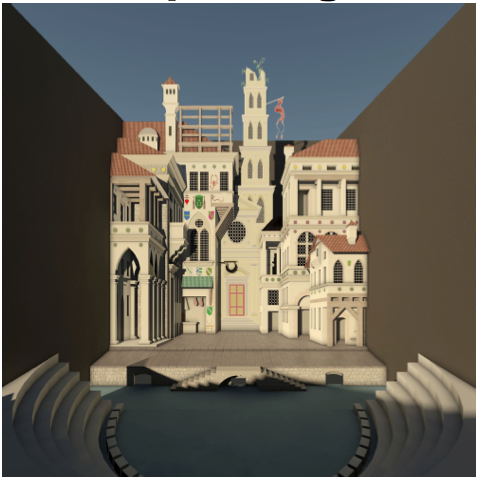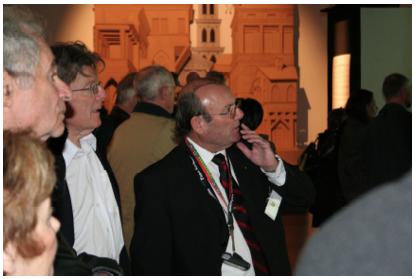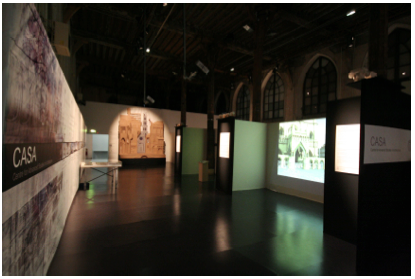Enhancing the public understanding of architecture
Submitting Institution
University of BathUnit of Assessment
Architecture, Built Environment and PlanningSummary Impact Type
CulturalResearch Subject Area(s)
Built Environment and Design: Architecture, Design Practice and Management
Studies In Creative Arts and Writing: Film, Television and Digital Media
Summary of the impact
Few can doubt the economic and social impact of the public's interest in
our historic environment. This case study describes how research in the Centre
for Advanced Studies in Architecture (CASA) at the University of
Bath has contributed to the public understanding of historic buildings and
landscapes, and to their preservation. The underpinning research pioneered
the application of computer-aided design techniques in modelling historic
architecture and landscapes. These innovative computer models have been
published in academic and popular monographs, and displayed in
well-attended public exhibitions and lectures in Europe and America. This
work has led to a demonstrable increase in public interest in, and a
change in understanding of, these buildings and landscapes. It has also
assisted national charities charged with their preservation (notably the
National Trust and the Beckford Tower Trust in Bath) as well as helping
architects to design new buildings in their proximity (notably in Bath).
Underpinning research
From the early 1990s, staff in CASA (Hart (1991-date, Professor of
Architecture), Harney (2003-date, PhD student, Lecturer), Richens
(2005-date, Professor of Architectural Computing), Shepherd (2007 to date,
Research Fellow, Lecturer), Day (until 2011, Professor of Architecture),
Wilson Jones (2000-date, Senior Lecturer), Tavernor (Professor until 2006,
VP 2009-date)) have played a lead role internationally in developing
research into the application of Computer Aided Design techniques
(originally developed for architectural design practitioners) to inform
traditional scholarship in the field of architectural history. Computer
models have been constructed in order to visualise and analyse important
historic buildings & rural and urban landscapes. In some cases the
buildings and landscapes in question were never realised or were
destroyed, and so the computer provided the only means by which they could
be assessed. In the case of the 1995 model of Serlio's Renaissance stage
(above), earlier researchers had analysed the spatial relationships of
Serlio's scene as depicted in his original woodcuts, but the computer
model constructed using them made it possible for the first time to assess
the accuracy of the earlier findings [1]. The model enables the assessment
of the effectiveness of Serlio's perspective scenes, for example when
viewed from seats on the edge. The underpinning research for these models
employed traditional scholarship in the form of archival work (identifying
plans, drawings and views), and translation of historic texts that also
informed the monographs in which the models were published. The research
techniques involved in making the post-2008 computer models whose public
impact is described below were developed through a pioneering series of
earlier models, each a refinement of the last, displayed in exhibitions or
published in leading monographs [2-6]. These models include: Serlio's
stage (National Theatre Museum, 1998), Soane's Bank of England (Royal
Academy, 1999), Stanley Spencer's Artists House (Tate Britain, 2001),
Hawksmoor's Oxford (monograph, 2002, see 2), and Napoleon's coronation
route through Paris (The Napoleon Foundation, Paris, and the National
Maritime Museum, 2005).

Since the mid-1990s CASA has also promoted the use of computer models in
the planning process, in developing tools to analyse and visualise
historic urban environments and landscapes. It has pioneered the
construction of very large computer models of urban environments, notably
through the model of the city of Bath contracted in the 1990s (sponsored
by Sainsbury's PLC) and continually updated (see: http://www.agocg.ac.uk/reports/visual/casestud/smith/models1.htm).
Workshops
held with the Prince's Foundation for the Built Environment in 2005,
attended by professionals, planners, academics and students, focussed on
how these computer tools could enhance public participation in heritage
planning and design. CASA's models are thus not only an innovative
research tool but also help to visualise to the public a new understanding
of historic buildings, landscapes and settings. The novelty of this
research has been recognised by our peers. Throughout the 1990s CASA
published in the journal Computers and the History of Art [1], and
its pioneering contribution was cited by Prof Will Vaughan in The
Subjects of Art History: Historical Objects in Contemporary Perspectives
(ed. M.A. Holly et al., C.U.P., 1998, ISBN-13: 978-0521455725 pp. 316-17,
fig.45).
References to the research
(1) Hart, V., Day, A., `A Computer Model of the Theatre of
Sebastiano Serlio, 1545', Computers and the History of Art,
Harwood Academic Publishers, 1995, vol.5 no.1, pp.41-52.
(2) Hart, V., Nicholas Hawksmoor: Rebuilding Ancient Wonders,
Yale University Press, London and New Haven, 2002. Awarded the Best
Book on British Art Prize of the College Art Association in 2005
(Can be supplied by the HEI on request).
(3) Hart, V., Day, A., `Investigating spatial effects in architecture and
painting: How historians are now using computer technology', in GIM
International, Reed Elsevier Group, September 2005, pp.13-15.
(4) Hart, V., Day, A., `The Architectural Guidebook: from Palladio to
Pod', Architectural Research Quarterly, vol.11 no.2, June 2007,
pp.151-58. DOI: 10.1017/S13591355007000620
(5) Hart, V., Sir John Vanbrugh: Storyteller in Stone, Yale
University Press, London and New Haven, Spring 2008; Shortlisted in
2008 by the Authors' Club for the Banister Fletcher Award (8 books)
(Can be supplied by the HEI on request).
(6) Hart, V., Inigo Jones: the Architect of Kings, Yale
University Press, London and New Haven, Autumn 2011; Shortlisted in
2012 for the William MB Berger Prize for British Art History (6 books),
and by the Author's Club for the Art Book Prize (8 books) (Can be
supplied by the HEI on request).
Grants:
(1) Hart, V., `A Computer model of Hawksmoor's Oxford', The Arts and
Humanities Research Board (AHRB), £4,847 for, Grant awarded in 1999-2000
[model published in 2 above].
(2) Wilson Jones, M., Richens, P., Computer-aided plotting of antique
columns, The early development and formal definition of the Ionic
capital, AHRC, £99,000, Nov 2005-Nov 2006.
The quality of this research is evidenced by the international book
prizes, and the international standing of the publisher (Yale UP) and of
the journals. For evidence on 6, see section 5 below.
Details of the impact
It is in the nature of architectural history that its outputs are of
interest to both an academic and a `popular' audience. The models
described here were made in order to `test' a new understanding of the
buildings and landscapes in question, as well as to visualise these in an
engaging way to the public. The chosen pathways to impact were public
exhibitions, lectures, and monographs, all of which have led to an
increased public awareness of the history and meaning of these buildings
as well as, more specifically in two Bath-based examples, to tangible
impacts for their custodians. Five post-2008 examples follow of how our
computer-visualisation research has led to public impact:
Hart's work on Andrea Palladio's four pilgrimage routes through Rome, as
described in his guidebooks of 1554, led to CASA's construction of a
computer model of them [see 4 above] and the translation of the guidebooks
published in 2006. This publication was reviewed in the popular press,
including The New York Times and The Times (by Jeanette
Winterson, see 1 below), assisting sales in general bookstores (including
Waterstones). A paperback edition appeared in 2009 and a Japanese one in
2011. Since 2008 (- December 2012, the last statement) it has sold 1,205
copies globally, through Amazon and bookshops, generating an income to the
American and UK publisher Yale UP of $22,308. The computer model of the
routes was publically exhibited at The British School at Rome, February
2008, funded by the British Academy and the Leche Trust; and at the George
Peabody Library, Johns Hopkins University, Baltimore, USA, March-April
2008, as part of the exhibition `Harmony to the Eyes' funded by the Samuel
Kress Foundation. Taken together, at least 700 people have seen the model,
ranging from the general public to academics and museum curators. The
exhibitions were supported by public lectures on the models by Hart at the
venues, each attended by around 200 people.
Computer models also informed Hart's monographs on John Vanbrugh and
Inigo Jones that were published in 2008 and 2011. They contained new
understandings of both architects, and computer models of their key
buildings that expressed this new understanding. The books and their
models have been widely reviewed in the popular press, including The
Oldie, Times Literary Supplement, Catholic Herald, The New York Times
and Apollo ("the author engages computer modelling and
reconstructions to flesh out his interpretations", see 2 below). They have
sold 2,973 copies globally (- December 2012, the last statement), through
Amazon (see 3 below) and bookshops, generating an income to Yale UP of
$116,768. The models of Vanbrugh's buildings formed the core of a
series of public lectures by Hart in 2008 in Baltimore, Philadelphia, and
Boston, thus reaching a more global audience, whilst the models of Jones's
buildings were discussed in public lectures at the Courtauld Institute,
London, the British School at Rome, the Universities of Kent and
Cambridge, as well as in talks and booksignings at Hatchards bookshop in
London and the Theatre Royal & Toppings Bookshop in Bath. The average
audience for the lectures was 100 people. Hart has also spoken about the
research results of the Jones models in radio broadcasts for Australian
National Radio and BBC Radio 4 (both 2012; `Unbuilt Britain' available on
the BBC website). A Senior Partner of Lynch Architects wrote to Hart: "we've
been referring to your work a lot recently" (see 4 below).
The publication of Hart's Vanbrugh monograph coincided with the
successful campaign by the National Trust to preserve Vanbrugh's Seaton
Delaval in public ownership: the book was used to promote this campaign in
a number of popular journals: Andrew Mead in the Architect's Journal
(28 August 2008) opened with the fact that the house's "future is
uncertain and the National Trust is trying to raise £6.3 million to `save'
it. The full significance of the house clearly emerges in [this] thorough
and absorbing new monograph", whilst Tim Knox (Director of the Soane
Museum) observed in the World of Interiors (1 October 2008) that
"the recent news" of the NT appeal "makes this new book...especially
timely". This public impact of the Vanbrugh monograph and its models led
to Hart being asked by the NT to be a co-signatory (headed by Lord Richard
Rogers) to an appeal letter published in The Times (6th
October 2008) see: http://www.beattiegroup.com/prclients/pr-press-releases.aspx?news=31&id=10051
There has also been close collaboration between CASA and the National
Trust on a number of computer visualisation projects, including a
fully-researched reconstruction of the original gardens of Prior Park in
Bath (by Hart, Richens and Harney in 2009). The model was built for a
public exhibition of CASA computer-history projects in collaboration with
the Sorbonne, Paris, held at the Réfectoire des Cordeliers, Paris, in
October 2009: see http://www.bath.ac.uk/news/2009/10/27/sorbonne-exhibition/.
The exhibition was visited by over 1,000 people, including students and
the general public, and was opened by the Sorbonne's President (George
Molinié). It was supported by a public lecture, attended by around 200.
The model is intended for display in the visitor's centre at Prior Park.
This project has led to a collaboration with the NT on Engineering
Doctorates (co-funded between the Trust and EPSRC) piloting the use of
digital technology in `real-life', heritage sites managed by them (by
Shepherd in 2010-date). The project has thus-far led to employment of two
students, part-based at the NT's HQ at Swindon. The Head Curator of the NT
comments: "Their research project...is already paying dividends,
and...has I believe begun to change the way that the Trust thinks about
the uses of new digital computing technologies" (see 5 below). Over
the years CASA's graduate student staff have been taught advanced computer
modelling techniques developed at Bath and have then moved into industry
and set up their own consultancies applying this research (eg Joe Robson
(M.Phil. 1997) and AVR London: see http://www.avrlondon.com/
).


Pre-2008 models listed above have also continued to find pathways
to impact during the REF period. Firstly, the Napoleon Paris model was
supplied in June 2010 to Kensington Communications for the Canadian
documentary series called `Museum Secrets', for broadcast in January 2011.
Additionally, it has had 7,673 downloads [at November 2013] on Youtube (http://www.youtube.com/watch?v=3uXhErt5agA)
and is linked via the Napoleon Foundation, Paris (http://www.napoleon.org/en/fun_stuff/video/index.asp).
Secondly, the computer model of Spencer's Artists House was displayed in
`Sir Stanley Spencer: Between Heaven and Earth', September 2011-January
2012, at the Kunsthal Rotterdam. And thirdly, the use of the Bath computer
model (Day and Hart) for the development of key new buildings such as the
Thermae Bath Spa with Grimshaw Architects in 2006, has led to its use for
the New Southgate Shopping Centre by Chapman Taylor Architects in 2010.
The model was used to carry out early proportional studies of the streets
and urban spaces in Bath as well as to provide the context for the
architectural visualisation that was used during public participation
exercises. Harney and Richens have worked with the Bath Preservation Trust
to develop and install in Beckford's Tower a fully interactive (by the
public) model of the area of Bath between Lansdown Crescent and the Tower
(£13K funded by the Heritage Lottery in 2011). This visualises the
landscape and buildings that William Beckford constructed between
1822-1844 and demonstrates them in new ways to the public. Its impact is
evidenced by increased visitor satisfaction at the Tower since its
instillation. The museum's Director comments: "The model has gone down
brilliantly at the Tower. The visitors' response has been fantastic,
with locals who had vague ideas about the ride as well as tourists
really getting a lot from what it reveals about Beckford's landscape and
how the Tower itself fitted into it. Young visitors spend a significant
amount of time using it and then want to go out in the cemetery to see
what is there now. Visit lengths have also been increased noticeably for
family groups, as the parents get a chance to spend time in the museum
while the children are playing on the model. That is very beneficial to
visitor experience and satisfaction, and to the recommendation to visit
the Tower they will then go home and give friends" (see 6 below).
Our impact, both cultural and economic, on the city of Bath as a visitor
attraction is notable, involving Beckford Tower, Prior Park, The Thermae
Bath Spa and Southgate. The total number of visitors to Bath and North
East Somerset each year is 4.5 million and the total tourism spend is just
under £350million (source: Bath Tourism Plus: http://visitbath.co.uk/media/information-sheets/btp-and-tourism-industry).
In terms of its reach, this research has thus had notable public impact
not only geographically (through book sales and public lectures in the UK,
USA, France, Australia, Holland, and Italy) but also through the high
profile of the venues, events and exhibitions. Carl Laubin, a leading
contemporary architectural artist, commented to Hart concerning the public
exhibition of Laubin's `Two Vanbrugh Capricci' at the Plus One Gallery,
London: "Your books on Hawksmoor and Vanbrugh were a great help to me"
(see 7 below).
Sources to corroborate the impact
(1) Jeanette Winterson on Palladio's Rome, The Times,
Saturday 5 August 2006. See:
http://www.jeanettewinterson.com/pages/journalism_01/journalism_01_item.asp?journalism_01ID=56
(2) Jason LaFountain on Inigo Jones, Historians of British
Art Newsletter, Winter 2012, pp.26-29. See: http://www.historiansofbritishart.org/Pub.asp?Mode=21
See also Timothy Mowl, Apollo, January 2012. See:
http://archive.is/XCtw
(3) Amazon: http://www.amazon.com/Sir-John-Vanbrugh-Storyteller-Studies/dp/0300119291/ref=sr_1_8?ie=UTF8&qid=1348135152&sr=8-8&keywords=vaughan+hart
(4) Senior Partner, Lynch Architects, email 18.7.2012
(5) Head Curator of the National Trust, letter 1.2.2013
(6) Director, Beckford Tower, email 10.8.2011
(7) Laubin, email 13.5.2011. See: http://www.plusonegallery.com/Artist-Detail.cfm?ArtistsID=424